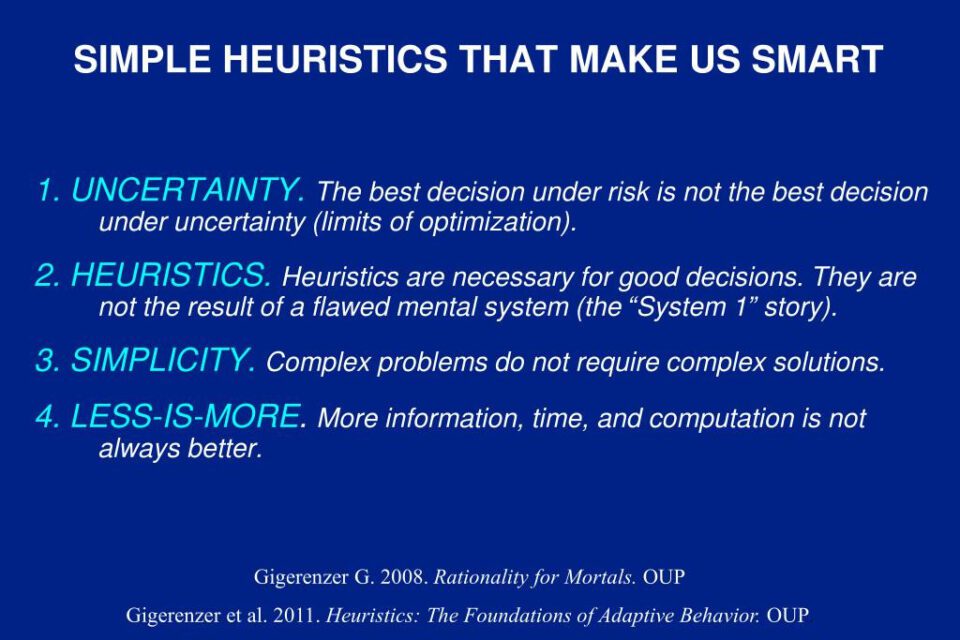Years ago, I read a book by Gerd Gigerenzer called “Simple heuristics that make us smart”. Gigerenzer—a German psychologist—defines fast and frugal heuristics as “simple, task-specific decision strategies that are part of a decision maker’s repertoire of cognitive strategies for solving judgment and decision tasks.” His thesis is that mental resources are scarce, and, therefore, that making decisions under real-world conditions require simple rules.
The analogy with water resources management is evident. Water managers rarely have the resources—in terms of data, people, models, understanding, time—to make decisions based on a comprehensive understanding of the complex hydrological, environmental, and socio-economic dynamics. Rather, information is routinely incomplete if not mostly absent, and deadlines are inevitably looming. Hence the appeal of using simple heuristics.
I was reminded of the concept of ‘fast and frugal’ heuristics when looking into two apparent contradictions in water resources management: nature-based versus technical solutions, and small-scale bottom-up measures versus large-scale top-down interventions.
Since the simple heuristic I wish to propose has its genesis in these two paradoxes, let’s have a closer look at them. We will get back to fast and frugal heuristics later. Alert: it will be quite a long (but necessary) detour.
Two paradoxes in water resources management
Are technical solutions and nature-based solutions complementary or mutually exclusive? Should one be preferred over the other? If so, when?
These queries have their origin in the resistance from ardent proponents of Nature Based Solutions (NBS) to our proposal to construct levees along the lower reaches of the Shabelle in Somalia. It provided the inspiration for a previous blog post “Is there a role for Nature Based Solutions to reduce floods in the dryland zone?”.
Another apparent contradiction in water resources management—which also came up in the same discussion on flood protection along the Shabelle—is concerned with small-scale bottom-up measures versus large-scale top-down interventions.
Let’s examine these two paradoxes.
Solution Space
The first step in this investigation is to draw up a ‘solution space’ that comprises of two axes: 1) type of intervention (ranging from nature-based to technical), and 2) type of management (on a spectrum from central to distributed). We then plot a typical set of measures—which are all part of the worldwide standard repertoire to address diverse water resources issues—in this solution space.
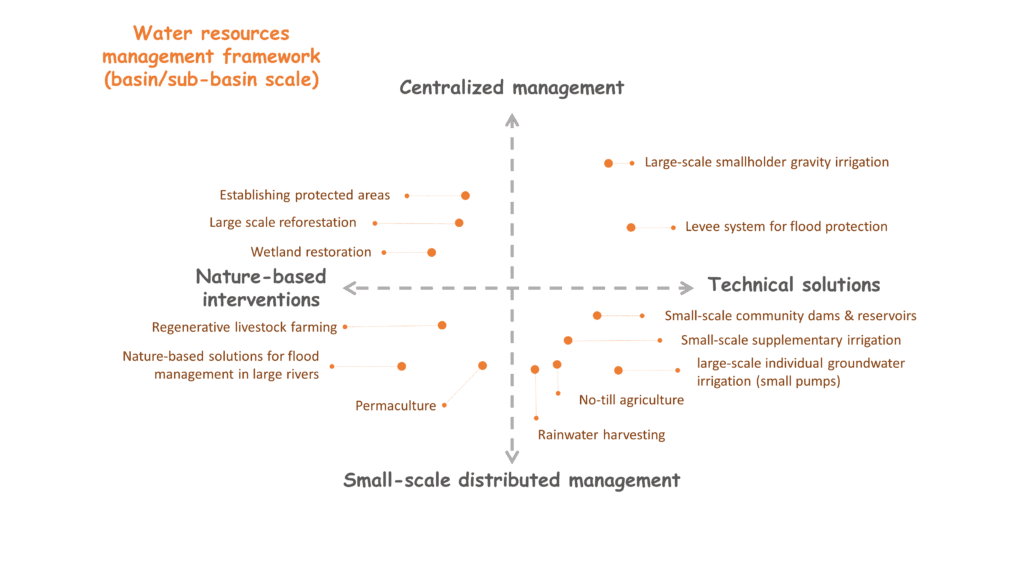
Note that the above solution space applies to basin and sub-basin level. Water resources management at smaller scales—such as district/county, large landholding, smallholder/plot—is different.
In the next step of this thought-experiment, another dimension—i.e.: sustainability—is added to this solution space. It reflects the observation that it is cheaper to establish interventions that are both “nature-based” and “small-scale-distributed”. Also, operating and maintaining these interventions requires less managerial capacity. In fact, most barely require external input after their construction or inception. It evidently represents a major advantage in an environment where funds for public projects are routinely scarce.
To visualize this new concept, the ‘water resources management framework’ sketched above was embedded in another frame, with axes: 1) managerial capacity and 2) financial resources. These two axes serve as a proxy for sustainability.
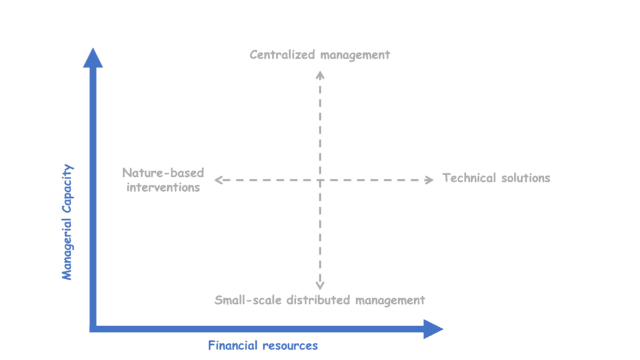
We assume an inverse relation between sustainability and the level of resources—in terms of funds and managerial capacity—required to establish, maintain, and operate a specific water resources management intervention. In this setup, small-scale nature-based solutions are more sustainable than large-scale interventions that require central management. I guess that’s sell-understood.
However, sustainability is not the only criterion that matters. The effectiveness of a measure is similarly important. In the above conceptual framework, effectiveness is a function (among others) of the scale of the issue that needs to be addressed. After all, what works in a small catchment may not work in a larger one. For instance, small-scale nature-based measures are probably overwhelmed by the sheer volume of the flood wave in the lower Shabelle, and by extension by the size of the catchment and extent of land degradation. It points to the (unwelcome) observation that some issues cannot be addressed by private or community action but must be addressed by collective action at a larger scale. I wish this was not the case. It alludes, unfortunately, to a major complicating factor in water resources management.
Feasible Solution Space
I have tried to reconcile the above discussion in a new figure. The circle represents the solution space that is both sustainable and effective. Hence measures that are located inside the circle are appropriate while those that are outside are probably not fit for purpose given the prevailing external conditions and scale of the challenge. Obviously, the circle is just an approximation. It will have ‘blurry boundaries’ in practice.
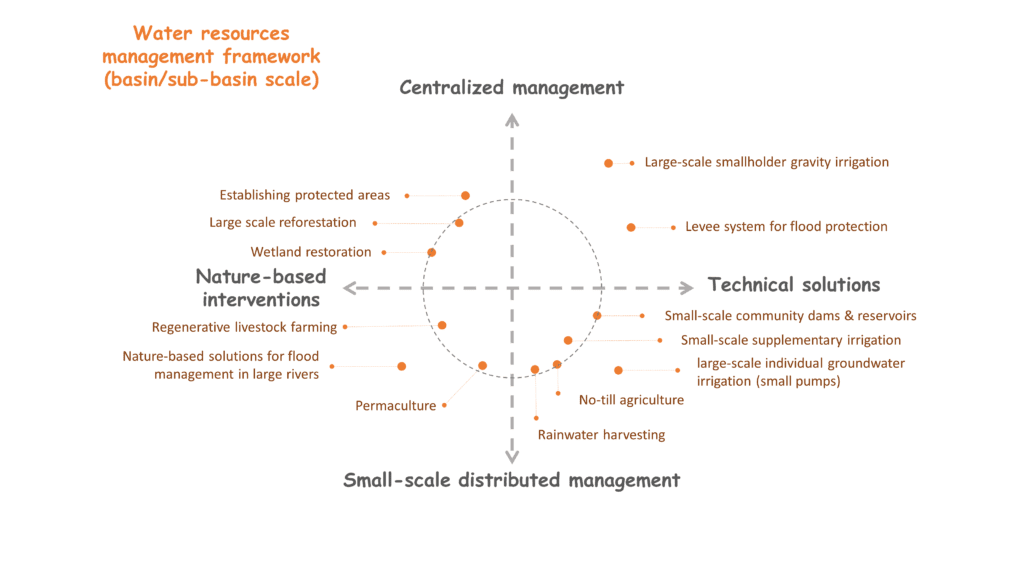
In the above figure, some measures are outside the ‘feasible solution space’. They are either too complicated or not effective given the scale of the challenge. For instance, establishing or expanding protected areas—which are associated with many beneficial impacts on the hydrological and environmental functions—is desirable but probably out of reach right for now in large parts of the world.
Can we bring those ‘outsiders’ back into the circle?
This is certainly possible. For instance, combining small-scale nature-based solutions with the “Room for the River” approach—that restores and widens the original floodplain but protects the land outside the floodplain with solid levees—would move the intervention “Nature-based solutions for flood management in large rivers” back into the circle. It represents a hybrid approach that combines nature-based and technical solutions and is therefore more appropriate given the volume of the anticipated flood wave.
With some creativity, most interventions that have initially been disqualified can return inside the circle. It will involve a combination of actions that:
- Reduce complexity.
- Reduce size (for large interventions)
- Increase size or scale (for small interventions).
- Combine with other interventions.
- Create beneficial assemblies.
- Change the policy or regulatory environment.
- Etc.
It is conceptually illustrated in the below figure.
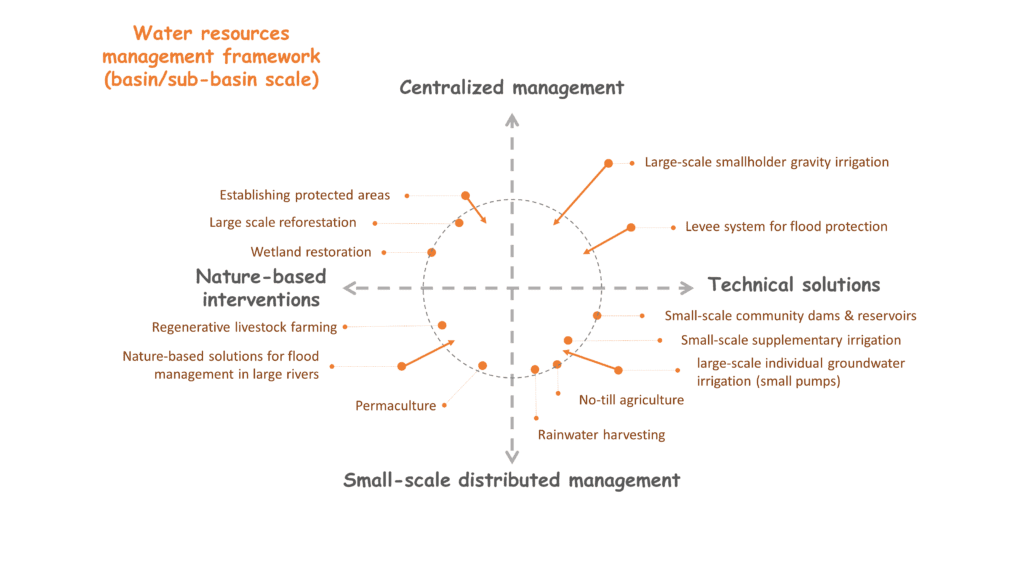
The dynamic aspect
Next, we should introduce a dynamic element to this discussion. Things change; they always do. For instance, the level of resources—in terms of funds and managerial capacity—can increase with a growing economy or a change in public preferences. Another example is depopulation in rural areas—which is accelerating in some parts of the world—that could make it easier to expand protected areas. In the conceptual framework introduced in this blog post, it would result in an expansion of the effective solution space, as illustrated in the below figure.
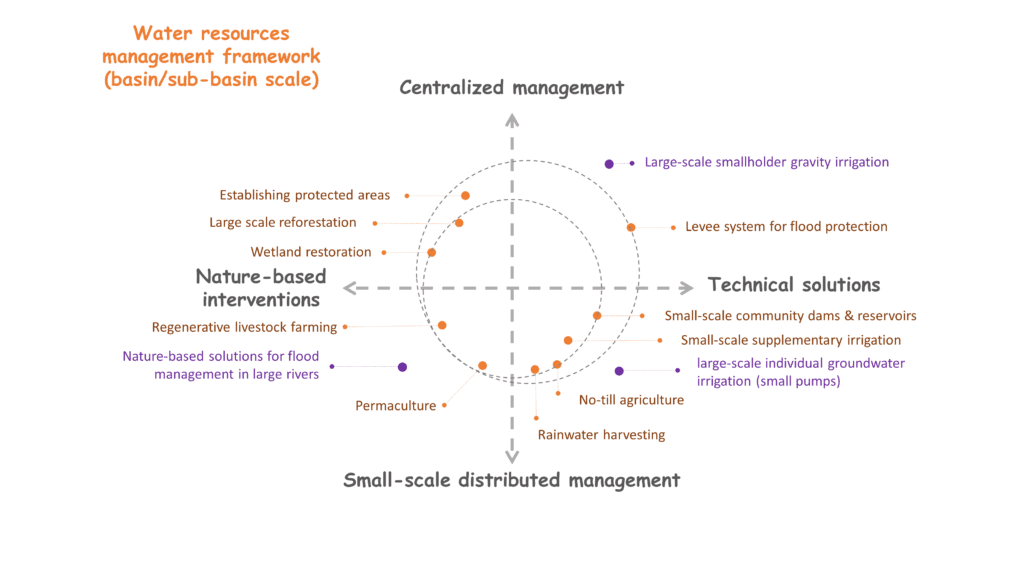
A few remarks on the interventions that remain outside the circle:
- Large-scale smallholder gravity irrigation remained an ‘outsider’. It reflects the difficulties experienced across the world—for instance in the Gezira in Sudan or in the large irrigation schemes in the Ramganga basin in India—to operate these large public irrigation schemes. Maybe things could be turned around by yet another injection of funds in combination with a dedicated effort from a highly qualified team. But why would you do this? Wouldn’t it be better to redesign the system to dramatically reduce its complexity? There are many options: break it up into smaller units; reduce its overall size; introduce an alternative water delivery system, etc. Human ingenuity is boundless.
- Some interventions simply cannot scale up to be effective in the given context. They can be considered for a different (i.e., smaller) scope but, on their own, not for addressing the current issue.
- Small-scale distributed interventions are generally preferred; however, if they collectively have a major adverse impact on the natural resource base but cannot be managed in practice, their application should be discouraged.
A fast and frugal heuristic in water resources management
We’ve finally come back to the discussion about heuristics.
The figure created in this post is a ‘fast and frugal’ heuristic. The circle—representing the ‘feasible solution space’ for a specific context and plotted in a simple graphic— serves as a filter to quickly identify unpractical solutions that probably won’t work in their current setup. It indicates where adaptations are required. It helps to eliminate interventions that look promising but are too complicated or do not scale up. It provides a justification to reject an intervention without having to go into in-depth discussions (and arguments). It provides a simple tool for decision makers to quickly review the feasibility, sustainability, and resilience of a program.
As a counter argument, you may insist that ‘outsider’ measures can be made to work, and that is probably true. But why would you do that? It is so much better—from a resilience and sustainability point of view—to just reduce the complexity of a measure so that it remains effective under a wide range of future conditions: less budget, less managerial capacity, different political priorities, climate change, etc. You can tweak every measure into something that fits inside the circle. Human ingenuity will see to that.
Hence from a decision maker’s perspective, this ‘fast and frugal’ heuristic engenders a sound management strategy that promotes effective, resilient, and sustainable long-term solutions!
For those interested in ‘fast and frugal’ heuristics:
ProsperO
This post was partly inspired by Klaas van Egmond’s book Homo Universalis. In one chapter, he (re)tells the story of the wizard ProsperO reconciling most antagonists in a circle. The story originates from Shakespeare’s Tempest and serves as a metaphor for the golden mean: the desirable middle between two extremes. Surprisingly—or maybe not, since these are old concepts dating back to Greek thought—the approach has some value in water resources management. Thus, ProsperO has also become a water wizard!
References
Gerd Gigerenzer, Simple heuristics that make us smart; Oxford University Press; First Edition (September 30, 1999)
Klaas van Egmond, Homo Universalis (in Dutch); De Geus, 2019
